Make Way for Ducklings and Chicks
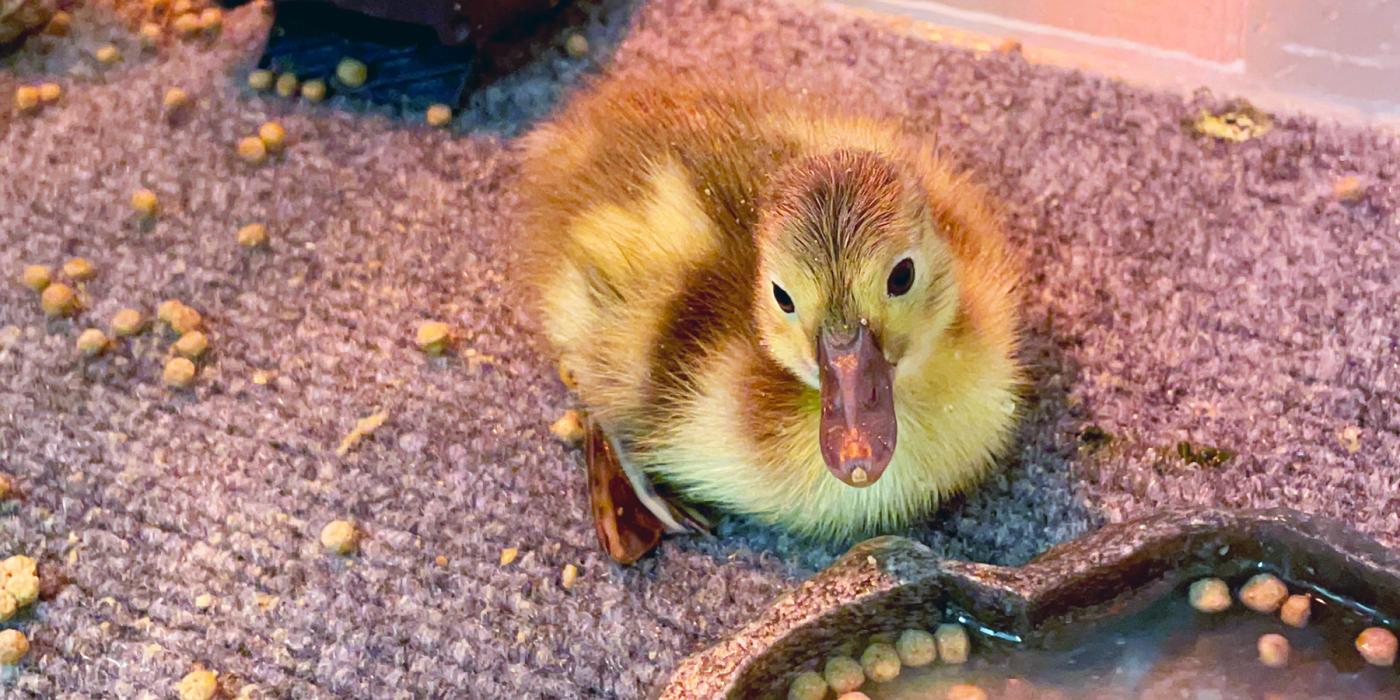
Take a summertime stroll through the Bird House, and you might be lucky enough to hear the sound of soft quacks and sweet tweets echo through the aviaries. On the wings of last year’s award-winning baby boom, our animal care team recently welcomed 27 chicks among seven duck and songbird species. Follow the fledglings in this behind-the-scenes look from curator Sara Hallager and keepers Stacy Hill and Jen Ferraro.
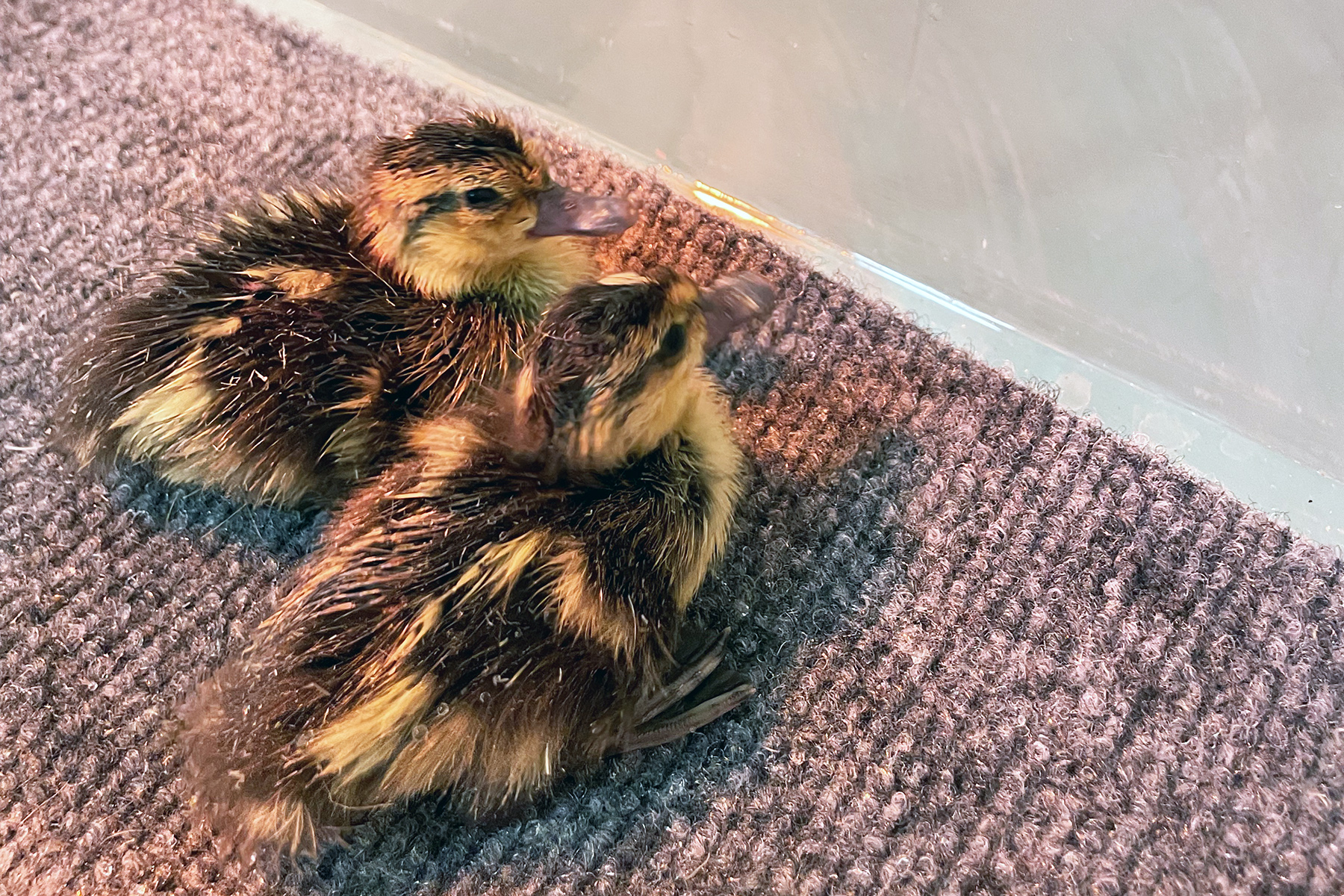
Canvasback
In the Bird House’s Prairie Pothole aviary, canvasbacks Rowena and Crowley welcomed five ducklings—the first of their species to hatch at the Zoo since the early 1990s! Both parents are mellow, easy going ducks with calm personalities. When it came time to breed, Crowley wooed Rowena with some snake-like head movements and a call that sounds a bit like the growl-bark of a bloodhound. This species usually prefers to nest in tall, secluded grasses, so we were taken aback when Rowena chose to nest right behind a public barrier! We thickened up the area with extra grasses to give her a private place to hide.
Canvasback moms typically incubate their eggs for about 30 days. As the hatch date approached, we removed the eggs from the public aviary to an incubator behind-the-scenes. This allowed us to keep the ducklings safe during their first few weeks of life. After they hatched, we fed them nutrient-rich pellets that are specially made for young ducks and gave them a shallow pool where they could wade and practice swimming.
Once they got big and strong enough to hold their own, we reintroduced them to the exhibit. They were so much fun to watch as they chased one another around the pool and showed off their amazing diving abilities! Soon, these juveniles will go off on their next big adventure—moving to other zoos around the country to serve as ambassadors for their species.
Although they do dive for food in their native habitat, one of their favorite plant-based foods is wild celery. This quirky diet influenced their scientific name (Aythya valisineria), which derives from that of wild celery (Vallisneria americana). Although visitors are not permitted to feed the Zoo’s ducks, you can feed ducks you come across in the wild! Instead of offering them processed foods (like bread), give them lettuce, grapes, peas or green beans, which are nutritionally appropriate and more easily digestible.
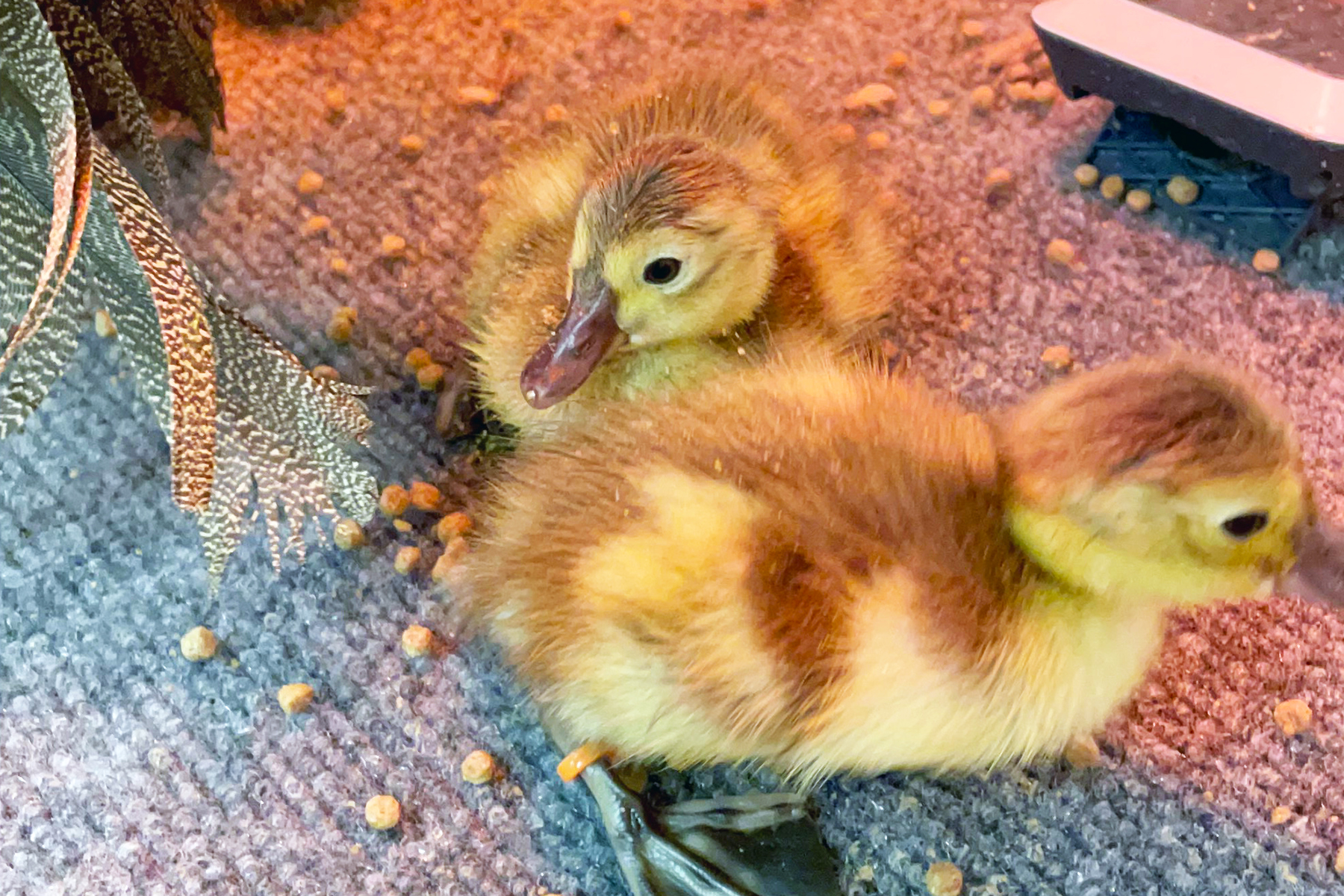
American Wigeon
The canvasbacks’ neighbors, American wigeons Lucy and Ricardo, also welcomed five little ones this summer, on June 30. Far from Crowley’s subtle snake-neck moves, Ricardo’s courtship displays involve chasing everyone out of the water and then swimming in a figure-8 pattern to capture Lucy’s attention. They are a sassy and vocal couple, and Ricardo’s high-pitched whistles sound similar to a kazoo.
American wigeons, too, incubate their eggs for about 30 days. Similar to the canvasbacks, we moved the eggs to an incubator just prior to hatching—with a twist. To mimic the incubation parameters of the female, we increased the humidity and monitored the hatching eggs carefully in case they showed any signs of trouble. Luckily, they did not! The newly hatched ducklings—who were just as sassy and vocal as their parents, were moved to a warm brooder for the first few weeks of life.
As the ducklings grew, they moved to a larger enclosure with water so they could exercise their natural diving behaviors. American wigeons eat the most greens of any duck species in North America. Their short bills are well adapted for forcefully plucking plants. Wigeons mainly nibble on aquatic vegetation, including wigeon grass (which is named for them), duck sedge, duckweed and cattails. Our wigeons’ diets—which consists of specially formulated pellets, mealworms and greens— allowed the ducklings to grow big and strong in just a few weeks. Soon they, like the young canvasbacks, will go to other zoos.
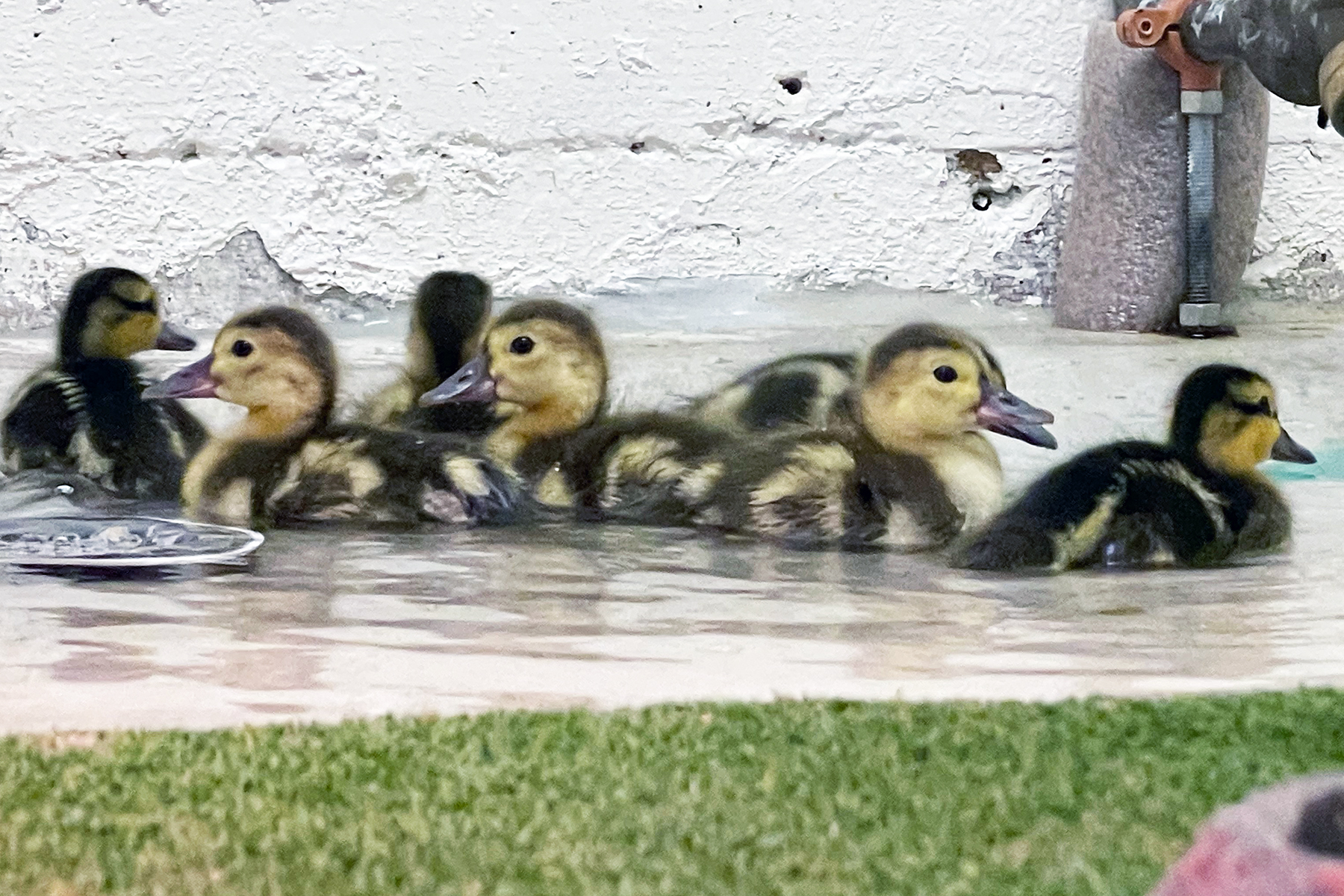
White-cheeked pintail ducklings (outer edges) swim with canvasback ducklings (center).
White-cheeked Pintail
For the first time in 14 years, the Bird House team welcomed white-cheeked pintail ducklings! All five emerged from their shells May 25 and have bold and dominant personalities, much like their parents.
Although white-cheeked males and females look similar in appearance, there are a few subtle ways to tell them apart. Size-wise, males are slightly larger and have more intensely colored plumage. They also have different vocalizations. Females call with a weak quack, while males give a low whistle.
Unlike most waterfowl species, female white-cheeked pintails initiate courtship! To show the males they are interested, they stiffen their necks and call with a series of subtle, descending quacks. In response, the males will move their heads up and down—showing the back of their neck—and vocalize with a high-pitched call that sounds a bit like a dog’s squeaky toy.
We provided the female with a nest box to lay her eggs in, and she incubated them for about 25 days. As the hatching date approached, we placed the eggs in an incubator behind the scenes so they could be safely hand reared. Many hand-reared ducklings spend much of the day under the heat lamp, coming out occasionally when keepers bring them food. But not the white-cheeked pintails! There were very active and constantly explored the enclosure. Now that the juveniles are almost as big as the adults, they will be sent to other zoos as ambassadors for their species.
White-cheeked pintails are a coastal species and are found throughout the Caribbean and South America. Unfortunately, populations are declining due to hunting by humans and predation of nests by dogs, cats, small mammals, land crabs, larger birds (including gulls) and amphibians (including bullfrogs). Their populations are declining so rapidly in Puerto Rico that the government considers them a species of concern. Even when well-fed, pet cats instinctively hunt and kill birds. Help protect birds by keeping cats indoors, training them to walk on a leash or creating an outdoor “catio.”
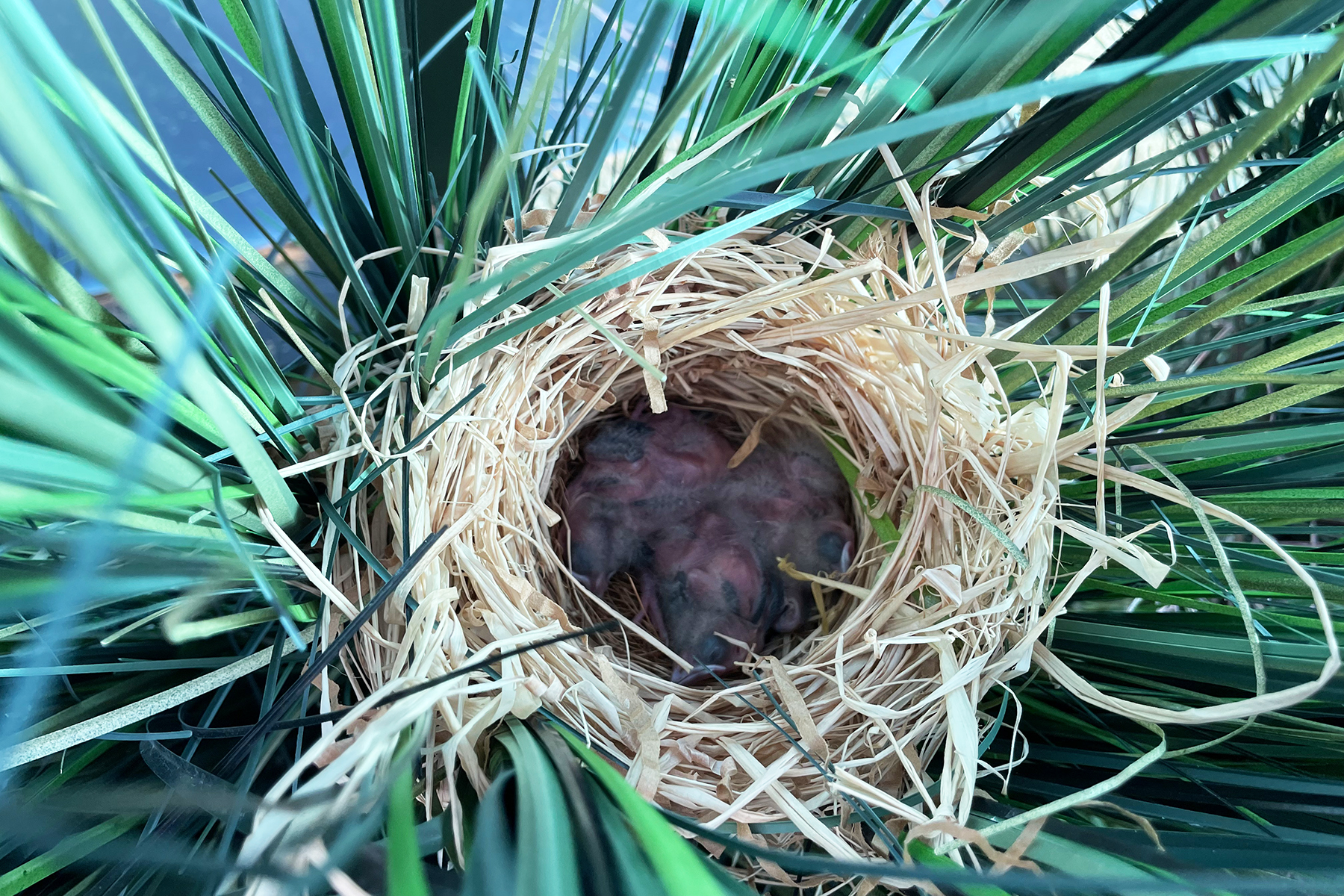
Red-Winged Blackbird
Our vibrant and charismatic red-winged blackbird parents Meadow and Huntley welcomed seven chicks this summer—the first ever to hatch at the Zoo! To attract their mates, males like Huntley perch out in the open and sing “conk-la-ree” while showing off their bright red shoulder patches, called epaulets.
In the wild, this species prefers to nest among marsh vegetation, shrubs and trees. In the Prairie Pothole aviary, we provided Meadow and Huntley with dried grasses for nesting materials, mimicking the reeds their wild counterparts use. This helped set the mood for breeding, and Meadow laid two clutches of eggs. The first hatched June 5 and yielded three chicks; the second brought about four more July 6. Females are the primary caregivers, through Huntley helped Meadow feed their chicks insects, including mealworms, crickets and waxworms. After about two weeks, the chicks fledged.
Despite being one of the most abundant birds in North America, the continental populations of red-winged blackbirds has declined 36% since the late 1970s. To help this species, we must preserve the wetland habitats where they live and raise their chicks. Keep wetlands clean by properly disposing of trash and being mindful of the chemicals you use around your home, including pesticides and fertilizers. These chemicals can runoff into local waterways and inadvertently make these birds and the animals they eat ill.
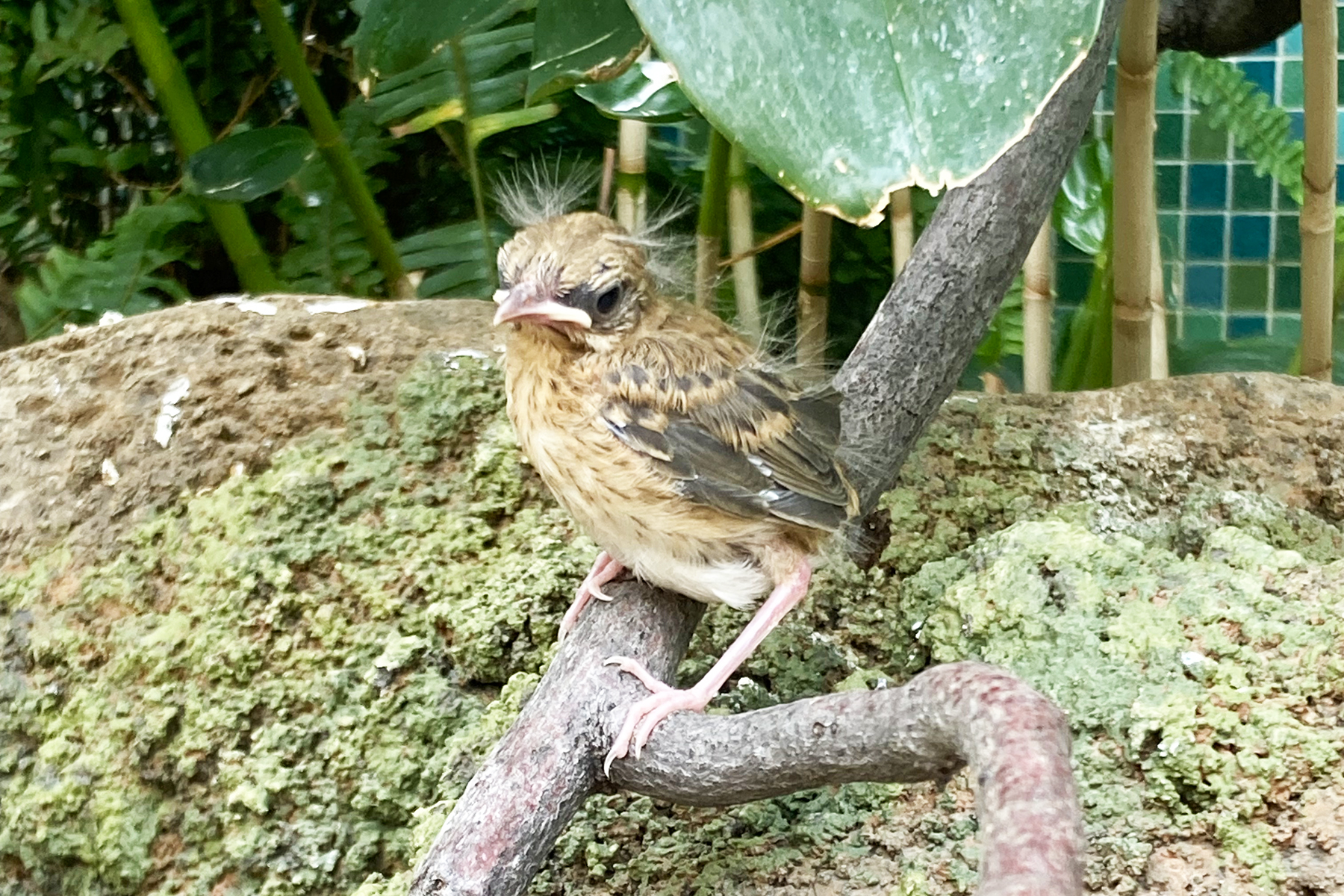
Ovenbird
Just a puddle jump away in the Bird Friendly Coffee Farm aviary, two very special ovenbird chicks emerged from their shells June 17. Our team was over-the-moon excited—this was our first successful attempt at breeding this species. To add yet another feather in our cap, Smithsonian’s National Zoo and Conservation Biology Institute is the only facility in the world breeding these feisty and secretive birds!
Unlike most warblers, which roost in trees, ovenbirds spend most of their time on the ground. They have a unique walk that looks like a high-stepping march. Spotting them requires patience and a keen eye, as they tend to wander out of view under the dense ferns. Even if all we can see is their shadowy silhouette, their “march” is an easy identifier! When they do go into the tree canopy, they walk straight down the branches instead of hopping or shuffling like other warblers do.
Typically, we hear ovenbirds before we see them. Males’ emit a call that sounds like, “Teacher. Teacher. Teacher.” Because they are so well-hidden, it is difficult to observe their courtship displays and breeding behaviors. That said, we knew the male successfully wooed the female when a dome-shaped nest appeared. We provided our pair with a variety of materials to build their nest. Some mimicked the same materials they would find in the wild: pine needles, dried leaves, raffia and moss. Others were more Zoo-centric offerings: shredded newspaper and hair from our bison (Lucy and Gally) and our alpacas (Orion and Cirrus)!
Ovenbirds tend to be feisty. They will challenge other birds in the aviary while foraging. To mimic the abundance of insects that we normally see in spring and summer, we provided mom and dad with a “breeding diet” (i.e. increased the amount of insects we feed). This helped cue the adults that there were plenty of resources to raise their chicks. Once the chicks hatched, the parents took over the care and feeding duties.
After about 10 days, the chicks fledged. To keep them back from the public walkway, we set up a small corral. This also helped us to monitor their health and development. It was fun to learn more about ovenbird courtship and watch the chicks grow!
In the wild, ovenbirds that nest east of the Appalachian mountains may overwinter in the Caribbean. Those west of Appalachia are more likely to migrate to Mexico or Central America. If you’d like to help ovenbirds, consider drinking Bird Friendly Coffee and eating Bird-Friendly Cocoa, as these products are gown in such a way that helps preserve their habitats.
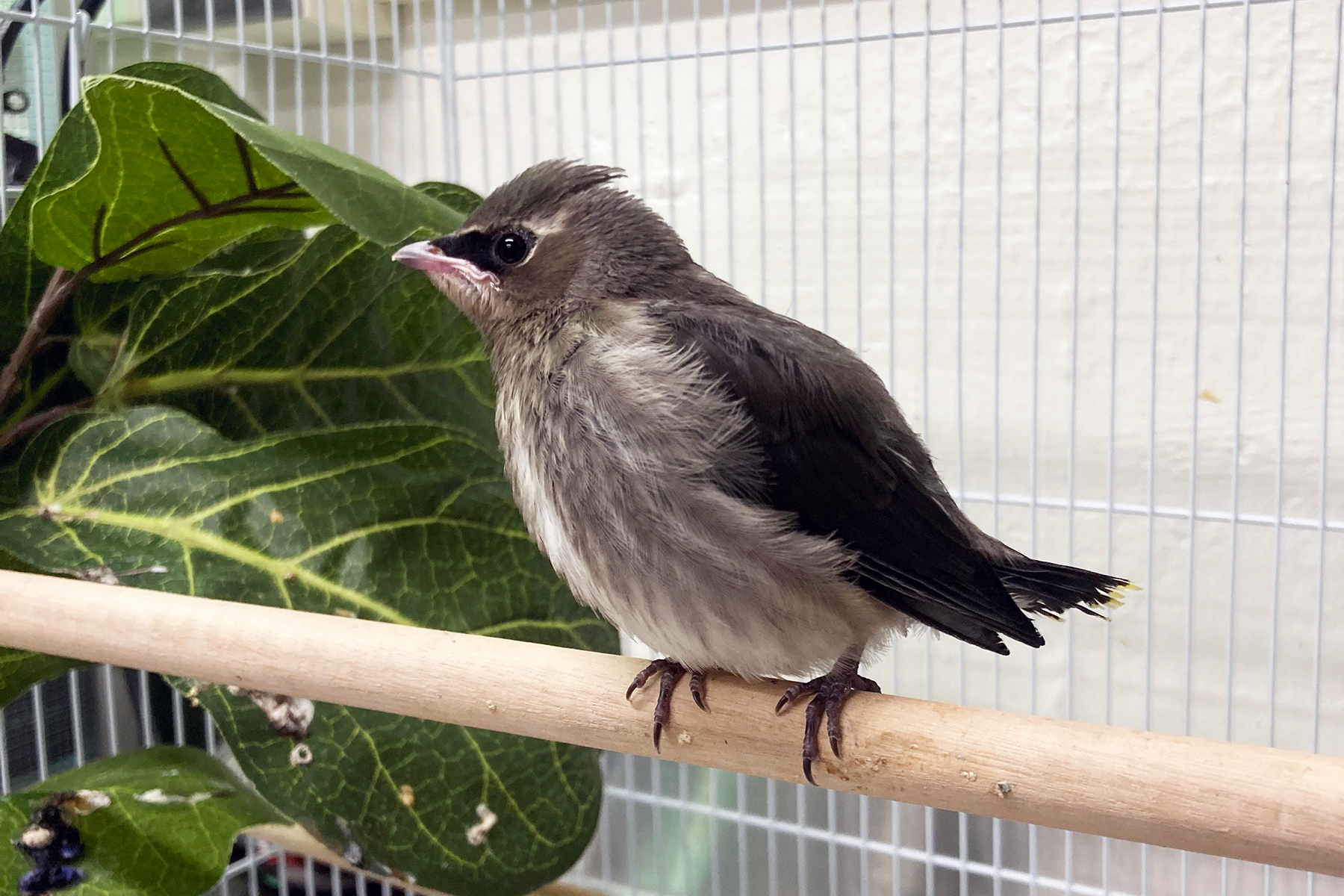
Cedar Waxwing
While the ovenbird family fills their bellies with insects, their neighbors—the cedar waxwings—are one of the few bird species native to North America that specializes in eating fruit. This species times its reproductive cycle based on when summer-ripening fruits are most plentiful. When chicks first hatch—as our chick did in mid-June—their diet is a mix of mostly insects and some fruit. By the time they are ready to fledge around 14 to 18 days old, their diet is more than 80% fruit!
Unlike the secretive ovenbirds, cedar waxwings are quite laid-back and easy to spot in the tree canopy. This gives us an excellent view of their interesting courtship behaviors! Males will stand on a perch and hop toward the female, and she will reciprocate. When they meet face to face, they will exchange small piece of food or flower petals with each other.
Our cedar waxwing couple received the same nesting materials as the ovenbird pair. Females construct their nests by weaving twigs, grasses and animal hair into a cup shape. To reassure the parents that there were plenty of resources, we offered them additional insects as well as chopped berries. Once their chick hatched, we gave them lots of insects the first few days, then steadily increased the fruit offerings.
Although they initially took care of the chick, around day 5 we noticed the parents were not visiting the nest anymore. We found the chick in good health and moved it to our hand-rearing room behind the scenes. Our team fed the chick every half-hour for 12 hours a day. As it grew, we incrementally spaced out feedings until it could eat on its own. We plan to reintroduce the chick to the aviary this fall, once breeding season is over.
As a frugivorous, seed-dispersing bird, cedar waxwings play an ecologically important role in the maintenance and regeneration of fruiting shrubs and trees. They also eat many of the insects that are attracted to these fruiting plants. Unfortunately, this means they may be especially vulnerable to pesticides. These chemicals can harm birds through direct contact or if they eat contaminated seeds or prey. You can help cedar waxwings by not using pesticides or insecticides at home and by buying organic foods, which are grown without artificial chemicals.
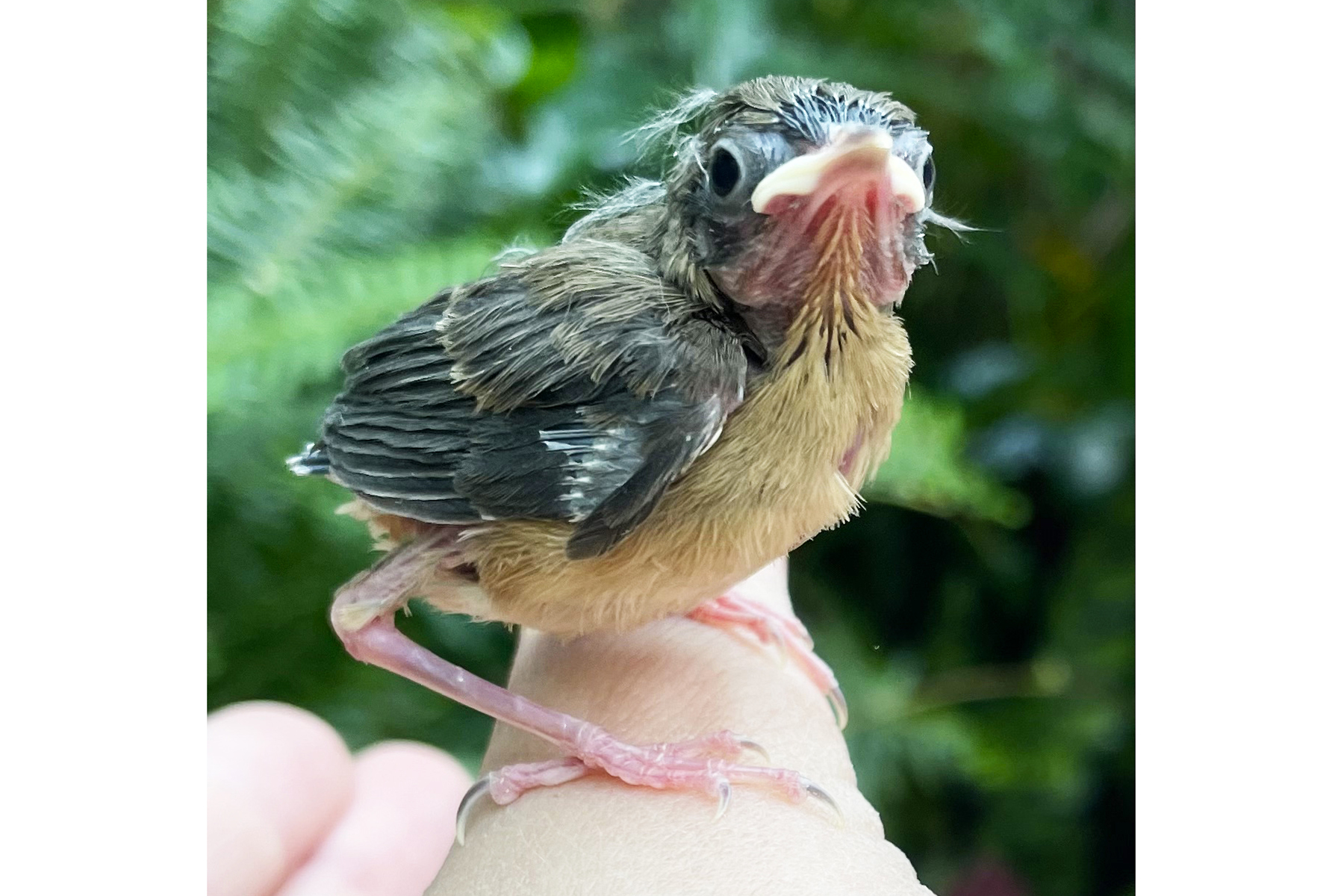
Common Yellowthroat
Around the time the cedar waxwing chick hatched, we also welcomed two common yellowthroat chicks. The siblings hatched June 18 and 19. Their arrival was quite special for our team, because we are the only facility in the world breeding this species!
Male common yellowthroats are easily identified by their bright yellow throats and black mask around their eyes and face. In parts of the Midwest, this bird is called the” yellow bandit” because its facial markings bear a striking resemblance to the Lone Ranger’s mask!
To attract mates and defend their territories, males sing a witchy-witch song. If a female is interested, she will flutter her wings and sing a series of chipping notes. Once we observed these courtship behaviors, we provided them with the same nesting materials as the ovenbirds and cedar waxwings to encourage nest-building. In the wild, females nest in open marshes and search among tangles of shrubs and weeds for a well-hidden place to build their nest. To build it, they weave together grasses and other plant material into a cup shape.
During breeding season, common yellowthroats eat mostly insects, which they either pick off of plant leaves or snatch from mid-air. We provided our pair with plenty of bugs to eat, including extra waxworms for the parents to feed their chicks.
Although we have bred these birds in the past, none of the chicks survived more than a few days. With each clutch, we learn more about the needs of the parents and chicks, and are able to supplement their diet to help chicks grow-up healthy. Our team works closely with our veterinarians and the nutrition team to refine our husbandry techniques.
We closely monitored this nest and were prepared to step in and assist should the parents need some extra help. This time around, they successfully raised their chicks. We are happy to report that the chicks fledged around 10 days old and have been doing great ever since.
Common yellowthroats are frequently spotted in neighborhoods around the Washington, D.C., area. Unfortunately, this species often collides with glass, resulting in their injury or death. You can help these and other songbirds by treating the glass in your home with bird strike prevention material or by applying tempera paint, which is long-lasting (even in rain), nontoxic and comes right off with a damp rag or sponge.
Curious about courtship? Keepers dish on some quirky dating and mating displays in Ducks of Our Lives. Want to meet our birds in person? Don’t miss the daily animal keeper demos! Check the schedule and plan your visit.
Related Species:


